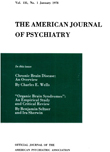Positive Spiking: A Double-Blind Control Study on Its Significance in Behavior Disorders, Both Diagnostically and Therapeutically
Abstract
To examine the diagnostic and therapeutic significance of the EEG pattern called 14 and 6 per second positive spiking, when it occurs in patients with behavior disorders, the authors studied 78 adolescent and young adult inpatients. Although they did find some support for their hypothesis that positive spiking might be regarded as a neurophysiological handicap which varies as a function of the patient's environment, they conclude that further investigation is warranted.
Access content
To read the fulltext, please use one of the options below to sign in or purchase access.- Personal login
- Institutional Login
- Sign in via OpenAthens
- Register for access
-
Please login/register if you wish to pair your device and check access availability.
Not a subscriber?
PsychiatryOnline subscription options offer access to the DSM-5 library, books, journals, CME, and patient resources. This all-in-one virtual library provides psychiatrists and mental health professionals with key resources for diagnosis, treatment, research, and professional development.
Need more help? PsychiatryOnline Customer Service may be reached by emailing [email protected] or by calling 800-368-5777 (in the U.S.) or 703-907-7322 (outside the U.S.).



